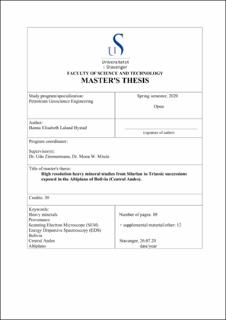| dc.contributor.advisor | Zimmermann, Udo | |
| dc.contributor.author | Hystad, Hanna Elisabeth Laland | |
| dc.coverage.spatial | Central Andes, Bolivia | en_US |
| dc.date.accessioned | 2020-09-29T13:32:02Z | |
| dc.date.available | 2020-09-29T13:32:02Z | |
| dc.date.issued | 2020 | |
| dc.identifier.uri | https://hdl.handle.net/11250/2680352 | |
| dc.description | Master's thesis in Petroleum Geosciences Engineering | en_US |
| dc.description.abstract | Heavy mineral studies play an important role in the understanding of a clastic sediment or sedimentary rock. The mineral composition of a clastic rock may reflect the provenance and sedimentological processes such as sorting and weathering of the detrital grains. Further changes of the original composition at time of deposition may be caused post-depositional by diagenesis and metamorphism. The identification of different sources is useful for different fields of study like correlation purposes, reservoir evaluation and paleogeography. Bolivia is strongly underexplored in this regard, even though hydrocarbon deposits are especially abundant and base metal mining is very abundant. Therefore, this study will be significant in terms of a pilot study to demonstrate the impact of high-resolution heavy mineral studies using an electron microscope coupled with energy dispersive spectroscopy. In this thesis, the method is applied to selected formations in the Bolivian altiplano, close to La Paz, of Paleozoic to Mesozoic ages, which span over 250 million years.
Heavy mineral samples from the Silurian Cancañiri Formation display well-rounded ultra-stable minerals, and a ZTR index of 61%, indicating high reworking of the sediments. The presence of pyrite points to anoxic deposition, which may correlate with consequences of sea-level rise after the Hirnantian glacial event and is a post-depositional effect pointing to the paleoclimate changes. The Devonian samples from the Vila Vila Formation also indicate similar degree of recycling (ZTR = 54%), although some euhedral, angular zircons were observed. In addition, arc-related amphiboles were of interest and may have been sourced by newly exposed metamorphic successions. Late Paleozoic rocks of the Copacabana Formation has a ZTR index of 57%. The shapes of the ultra-stable minerals indicate multiple sources. Chutani Formation rock samples straddling the Permian-Triassic boundary comprise non-oxidized iron grains which are clear signs of an oxygen depleted depositional environment. The ZTR index for the Chutani Formation is 46%, while the Mesozoic samples of the Triassic Tiquina Formation has a ZTR index of only 23%, making it the less reworked of the five formations. The former contains amphiboles and larger amounts of apatite, which could relate to a volcanic arc. The existence of fragile minerals in some formations, such as monazite or amphibole, can point to high sedimentation rates and rapid burial combined with a rather low burial diagenesis and thin post-sedimentary cover successions. This implies that the sensitivity of high-resolution heavy mineral studies in deciphering provenance changes based on a changing tectonic environment during the Paleozoic-Mesozoic in northwest Bolivia. | en_US |
| dc.language.iso | eng | en_US |
| dc.publisher | University of Stavanger, Norway | en_US |
| dc.relation.ispartofseries | Masteroppgave/UIS-TN-IER/2020; | |
| dc.rights | Navngivelse 4.0 Internasjonal | * |
| dc.rights.uri | http://creativecommons.org/licenses/by/4.0/deed.no | * |
| dc.subject | petroleumsgeologi | en_US |
| dc.title | High resolution heavy mineral studies from Silurian to Triassic successions exposed in the Altiplano of Bolivia (Central Andes) | en_US |
| dc.type | Master thesis | en_US |
| dc.subject.nsi | VDP::Teknologi: 500::Berg‑ og petroleumsfag: 510::Geoteknikk: 513 | en_US |
| dc.subject.nsi | VDP::Matematikk og Naturvitenskap: 400::Geofag: 450::Petroleumsgeologi og -geofysikk: 464 | en_US |

